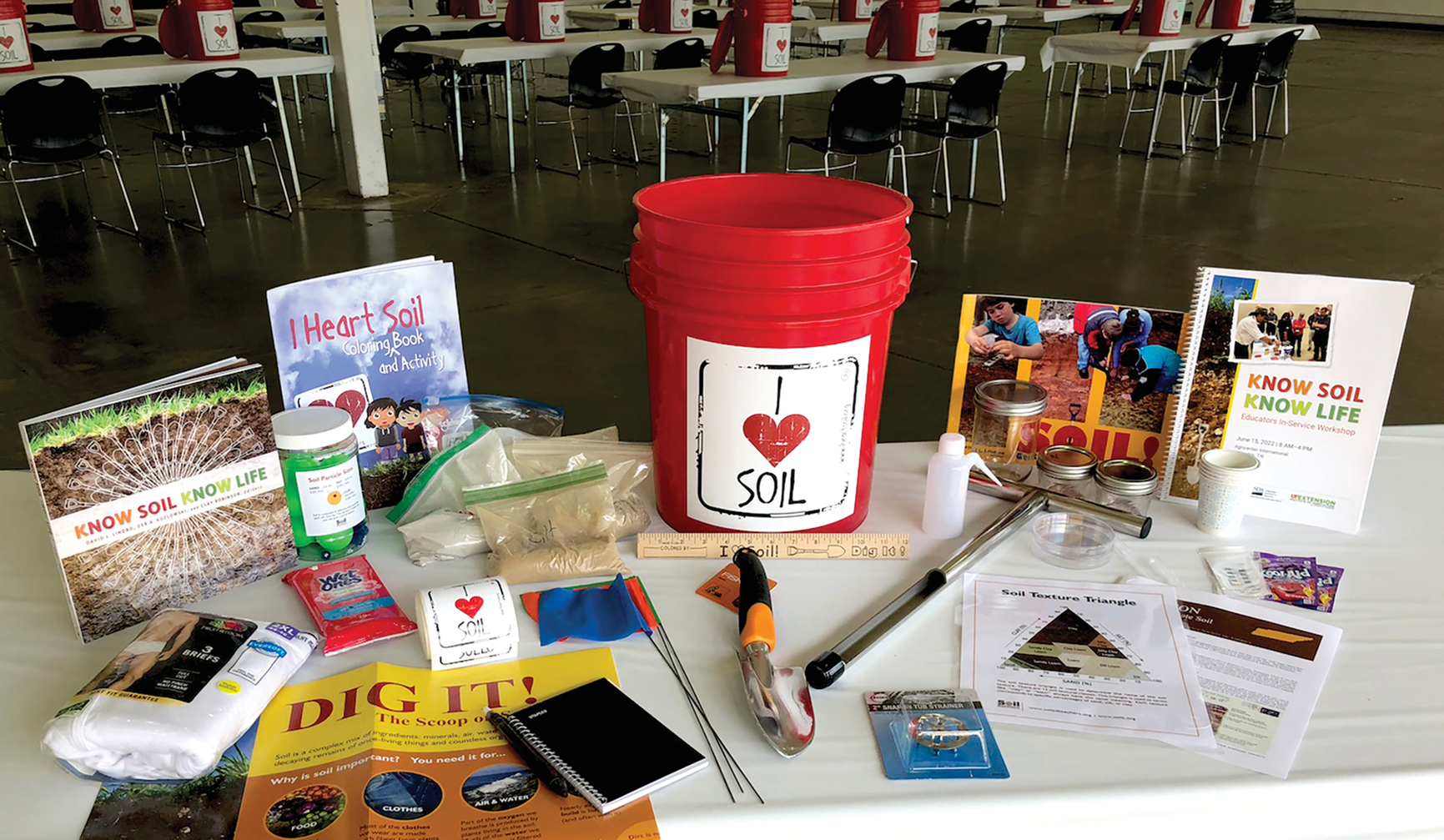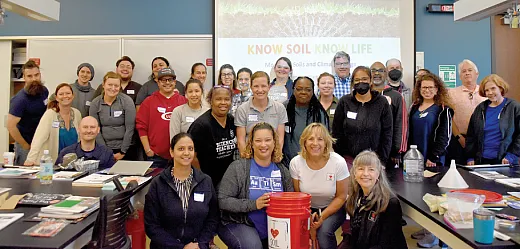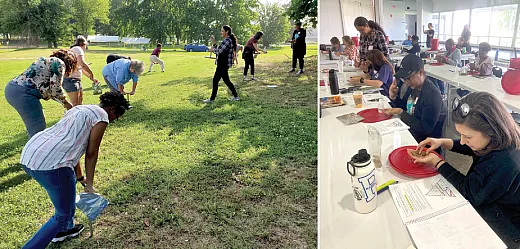Taking Soil Science to K-12 Classrooms!

The SSSA K‐12 Committee works to increase awareness of soil and environmental science disciplines among K‐12 teachers and students, develop age‐appropriate classroom activities and educational content, and train K‐12 educators to utilize these resources in their classrooms. Recently, committee efforts funded by SSSA and the Natural Resources Conservation Service (NRCS) have targeted urban school districts where soil science is less frequently taught and where there are large populations of groups historically underrepresented in the earth sciences, including women and people of color.
This work culminated in two one‐day educator trainings for K‐12 teachers where soil scientist members of our committee trained teachers on key sub‐disciplines within soil science, demonstrated relevant in‐class activities that teachers can use in their classrooms, and provided the necessary supplies to support the teaching of soil science in often‐underfunded schools. Both a pre‐ and post‐training assessment were conducted by an educational evaluator to assess the impact of these outreach efforts.
“The workshop was very well thought out. It gave many different labs and exercises to do with students as well as content information to better prepare myself for teaching.”
Soil Buckets
During these trainings, teachers were provided with “soil buckets” containing more than $200 of materials and supplies. These buckets were developed and provided to participating teachers free of charge. In addition, teachers were given copies of many SSSA educational resources, including the Know Soil Know Life textbook, Soil! Get the Inside Scoop book, posters, and coloring books. Teachers were also provided with PowerPoint slides, activities, and other resources that enable them to easily integrate the lessons they learned about into their existing curriculum.
View the video trailer of the in‐service and training materials page at soils4teachers.org/inservice. The SSSA K‐12 Committee has being doing great work since 2006. Learn about all of their activities and accomplishments at soils4teachers.org/accomplishments.
Training Modules
Training content focused on the pillars of soil science—physics, chemistry, and biology—as well as a module on soils and climate change (Table 1). These topics were chosen so that teachers would better understand how to relate soil science to their existing curriculum. Most teachers attending the trainings teach biology, chemistry, or other “pure” sciences, and many were not aware of how soil science may relate to their subject; these workshops were designed to help them see those connections. Teachers were taught the basic soil science concepts needed to understand the content of each module and learned how to complete each hands‐on activity.
| Module | Activities | Materials |
|---|---|---|
| Soil Basics and Physics | soil sampling, texture by feel | soil probe, squirt bottle, texture by feel flow chart |
| Soil Chemistry | soil as a filter, soil pH | Kool-Aid, paper cups, sand, pH test strips |
| Soil Biology | soil your undies, soil “glue”, berlese funnel | 2XL cotton underwear, strainers, glass jars, petri dishes, pipettes |
| Soils and Climate Change | GLOBE protocols, runoff simulation | posters, online resources |

Workshops
Memphis
The first training event was conducted at Agricenter International in Memphis, TN on June 15, 2022. This training reached 19 teachers, 59% of whom teach in Title 1 schools. Middle school teachers made up 63% of the group, who primarily teach general science and life sciences courses. Prior to the workshop, teachers indicated that low content knowledge, lack of classroom resources, and lack of relevant instructional materials were the top three barriers to teaching soil science lessons in their classes. After the workshop, teachers indicated that they have the necessary content knowledge as well as increased access to classroom resources and materials to bring soil science into their classrooms.
Chicago
The second workshop was held in Chicago, IL at DePaul University on Sept. 24, 2022. Twenty‐four teachers attended this workshop, 50% of whom were from Title 1 schools. Just over half of the educators teach middle school, and 36% are high school teachers. The same three barriers were identified by teachers as reasons they do not currently teach soil science—low content knowledge, lack of classroom resources, and lack of relevant instructional material. Similar to the Memphis training, teachers reported that they are more prepared in each of these areas after the training.

Collectively, we estimate that these teachers will present soil science lessons to more than 4,500 students per semester!
Feedback From Teachers
Both workshops were well received by the teachers, and many commented that the workshops were the best in‐service trainings they had experienced. “I learned about basically a whole new world today. The world underground,” commented one teacher. Said another, “Soil is such an important topic for everyone to understand. My current curriculum is outdated, not at all local, and fails to connect my students to real world issues. I want to teach my kids about soils as our soils are a precious resource.”
Next Steps
To disseminate the educational materials developed for the workshop and make them available to other K‐12 teachers, a webpage was created on the SSSA K‐12 Committee’s website for teachers—soils4teachers.org. The materials include topical overviews, PowerPoint slides, a recording of each module as it was taught at the in‐person trainings, activities with instructions, and a detailed list of the soil science bucket materials. This website is being actively advertised to teachers as a resource both for their knowledge development and for use in their classrooms.
The SSSA K‐12 committee is also working on informing our members of the availability of these turnkey modules, so they can take soil science to local classrooms and informal education workshops in their area!
Thank You SSSA K‐12 Committee Members
Thank you to these SSSA K‐12 Committee members for their dedication to this project, hosting the in‐service workshops, content development, and presentations:
- Jennifer M. DeBruyn, University of Tennessee–Knoxville Department of Biological Engineering and Soil Science
- Margaret A. Holzer, Great Minds, PBC James A. Montgomery, DePaul University College of Science and Health
- Maninder K. Walia, University of Nevada–Reno College of Agriculture, Biotechnology, and Natural Resources
- Briana M. Wyatt, Texas A&M University–College Station Department of Soil and Crop Sciences
- Susan Chapman, ASA, CSSA, and SSSA
SSSA and the K‐12 Committee also thank the USDA‐NRCS for its support of this project!
Text © . The authors. CC BY-NC-ND 4.0. Except where otherwise noted, images are subject to copyright. Any reuse without express permission from the copyright owner is prohibited.











